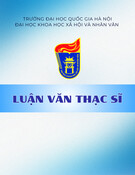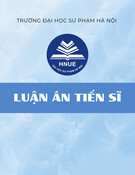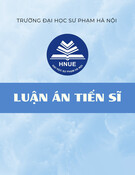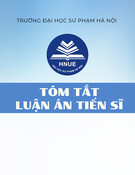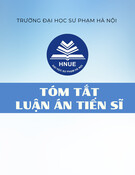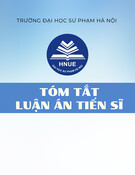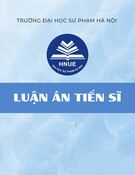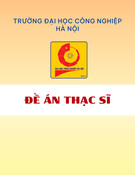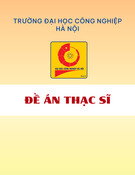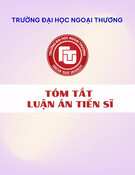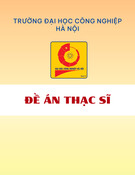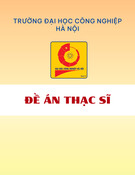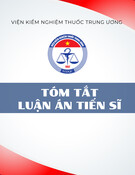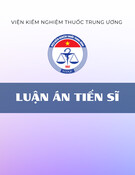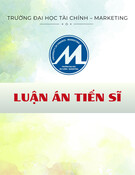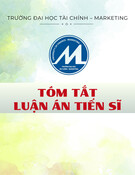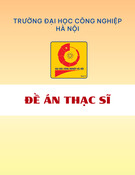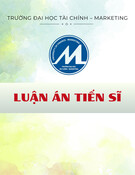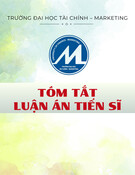
BỘ GIÁO DỤC VÀ ĐÀO TẠO
TRƯỜNG ĐẠI HỌC SƯ PHẠM HÀ NỘI
ĐỖ THỊ LAN
PHÁT TRIỂN NĂNG LỰC ĐỌC HIỂU
CỦA HỌC SINH TRONG DẠY HỌC VĂN BẢN
VĂN HỌC LỚP 9
Chuyên ngành: Lý luận và PPDH bộ môn Văn và Tiếng Việt
Mã số: 9.14.01.11
TÓM TẮT
LUẬN ÁN TIẾN SĨ KHOA HỌC GIÁO DỤC
HÀ NỘI - 2023

CÔNG TRÌNH ĐƯỢC HOÀN THÀNH TẠI
TRƯỜNG ĐẠI HỌC SƯ PHẠM HÀ NỘI
Người hướng dẫn khoa học:
2. GS. TS Nguyễn Thanh Hùng
Phản biện 1: PGS.TS Hoàng Thị Mai
Trường Đại học Hồng Đức
Phản biện 2: PGS.TS Phan Thị Hồng Xuân
Trường Đại học Sư phạm Hà Nội
Phản biện 3: PGS.TS Lê Thời Tân
Trường Đại học Thủ đô Hà Nội
Luận án sẽ được bảo vệ trước Hội đồng chấm luận án cấp Trường họp tại
Trường Đại học Sư phạm Hà Nội vào hồi …..giờ … ngày … tháng… năm…
Có thể tìm hiểu luận án tại thư viện: Thư viện Quốc Gia, Hà Nội
hoặc Thư viện Trường Đại học Sư phạm Hà Nội
1. TS. Nguyễn Trọng Hoàn

DANH MỤC CÔNG TRÌNH KHOA HỌC
LIÊN QUAN ĐẾN LUẬN ÁN
1. Đỗ Thị Lan, 2016. Nâng cao năng lực đọc hiểu tác phẩm văn chương cho
học sinh lớp 9 thuộc huyện Ân Thi, tỉnh Hưng Yên, Tuyển tập công trình
nghiên cứu Ngữ văn học, Tuyển tập công trình nghiên cứu ngữ văn học,
Nxb Đại học Sư phạm, tr. 524 - 529
2. Đỗ Thị Lan, 2016. Phát triển năng lực đọc hiểu của học sinh khi dạy học
đoạn trích “Những ngôi sao xã xôi” của Lê Minh Khuê [Ngữ văn 9], Tạp
chí Giáo dục, ISSN 2354 0753, số 392 (kì 1 - 4/2016), tr. 34 - 37
3. Đỗ Thị Lan, 2016. Dạy học đọc hiểu văn bản tự sự Ngữ văn 9 - Đôi điều lưu
ý, Tạp chí Giáo dục, ISSN 2354 0753, số 392 (kì 2 - 10/2016), tr. 45 - 47
4. Đỗ Thị Lan, 2018. Dạy học bằng trải nghiệm qua hình thức kịch hóa văn
bản Hoàng Lê Nhất thông chí của tác giả Ngô Gia Văn Phái (Ngữ văn 9,
tập 1) nhằm phát triển năng lực đọc hiểu cho học sinh tại trước trung học
cơ sở Bắc Sơn, huyện Ân Thi, tỉnh Hưng Yên, Tạp chí Giáo dục, ISSN
2354 0753, số 442 (kì 2 - 11/2016), tr. 41 - 48
5. Đỗ Thị Lan, 2018. Practising reading skills in teaching the poem “Dong
chi” [Comrade] of year - old children using Montessori method, Tạp chí
Giáo dục, ISSN 2588, số 04 (kì 24- 9/2018), tr. 45 - 47
6. Đỗ Thị Lan, 2022. Phát triển năng lực đọc hiểu văn bản văn học của học
sinh lớp 9 trong dạy học bài thơ “Sang thu” (Hữu Thỉnh), Tạp chí Giáo
dục. ISSN 2354 0753, số đặc biệt 7, (6/2022), tr.36 - 40
7. Đỗ Thị Lan, 2022. Cấu trúc phát triển năng lực đọc hiểu văn bản văn học
của học sinh lớp 9 trong dạy học môn Ngữ văn, Tạp chí Giáo dục. ISSN
2354 0753, số đặc biệt 7, (6/2022), tr.6 - 9

1
MỞ ĐẦU
1. Lí do chọn đề tài
1.1. Xu hướng toàn cầu hóa kéo theo những đòi hỏi mới về nguồn nhân lực
1.2. Phát triển năng lực đọc hiểu – một nhiệm vụ trọng tâm trong dạy học
đọc hiểu văn bản của môn Ngữ văn là vấn đề cần được quan tâm
1.3. Thực tiễn dạy học theo định hướng phát triển năng lực đọc hiểu văn bản
văn học ngày nay vẫn còn nhiều vấn đề “mở ngỏ”
1.4. Tầm quan trọng của việc dạy học đọc hiểu văn bản văn học lớp lớp 9
2. Đối tượng và phạm vi nghiên cứu
Đối tượng nghiên cứu
Năng lực đọc hiểu và các biện pháp phát triển năng lực đọc hiểu VBVH của
HS lớp 9.
Phạm vi nghiên cứu
Vấn đề phát triển năng lực đọc hiểu của HS đã được bàn đến ở nhiều khía
cạnh/bình diện khác nhau, đây là một vấn đề rộng lớn. Vì vậy, chúng tôi giới hạn
phạm vi của vấn đề nghiên cứu ở:
- Năng lực đọc hiểu và cách thức tổ chức dạy học để phát triển năng lực đọc
hiểu của HS lớp 9 trong dạy học VBVH.
- Đối tượng: Học sinh lớp 9.
3. Mục đích và nhiệm vụ nghiên cứu
Mục đích nghiên cứu
Luận án hướng tới mục đích phát triển năng lực đọc hiểu VBVH của HS
lớp 9 thông qua hệ thống các chiến thuật tác động trực tiếp hoặc gián tiếp đến
quá trình đọc hiểu VB của HS lớp 9 qua ba giai đoạn trước khi đọc, trong khi
đọc và sau khi đọc. Qua đó góp phần đổi mới căn bản, toàn diện nền giáo dục
theo định hướng phát triển phẩm chất và năng lực người học.
Nhiệm vụ nghiên cứu
Để đạt được mục đích nghiên cứu đặt ra, chúng tôi xác định các nhiệm vụ cụ
thể như sau:

2
- Tổng quan tình hình nghiên cứu về đọc hiểu, năng lực đọc hiểu, dạy học
phát triển năng lực đọc hiểu cho người học.
- Nghiên cứu những lí luận liên quan đến đề tài như ĐHVB, NLĐH, phương
pháp và kĩ thuật dạy học ĐHVB nhằm phát triển NL HS.
- Khảo sát thực tiễn dạy học đọc hiểu VBVH và phát triển NLĐH văn bản
văn học của HS lớp 9.
- Cách thức tổ chức dạy học VBVH hướng đến phát triển năng lực đọc hiểu
VBVH của HS lớp 9
- Dạy thực nghiệm kiểm tra hiệu quả của phương pháp và biện pháp đề xuất
phát triển năng lực đọc hiểu VBVH của HS lớp 9
4. Phương pháp nghiên cứu
Các nhóm nghiên cứu được sử dụng chính trong luận án:
Nhóm phương pháp nghiên cứu lí luận gồm: phương pháp phân tích và
tổng hợp lí thuyết; phương pháp phân loại.
Nhóm phương pháp nghiên cứu thực tiễn gồm: phương pháp điều tra;
phương pháp thực nghiệm sư phạm.
5. Giả thuyết khoa học
Nếu luận án đề xuất được những biện pháp phát triển NLĐH của HS lớp 9 là
những chiến thuật đọc hiểu tác động trong các giai đoạn trước, trong và sau khi
đọc văn bản dựa trên cơ sở nghiên cứu lý luận kết hợp thực tiễn thì luận án sẽ
đóng góp vào việc nâng cao chất lượng dạy và học Ngữ văn hiện nay.
6. Đóng góp của luận án
Về lí luận
Luận án khái quát tình hình nghiên cứu về đọc hiểu VBVH, NLĐH văn bản
văn học trong và ngoài nước;
Xác lập cơ sở lí thuyết về dạy học đọc hiểu VBVH của HS lớp 9.
Về thực tiễn
Luận án đề xuất một số biện pháp phát triển năng lực đọc hiểu VBVH của
HS lớp 9, cụ thể là sử dụng một số chiến thuật đọc hiểu vào trong các giai đoạn
trước, trong và sau khi đọc VB để kích hoạt tri thức nền, nâng cao và phát triển
năng lực đọc hiểu cho HS..

